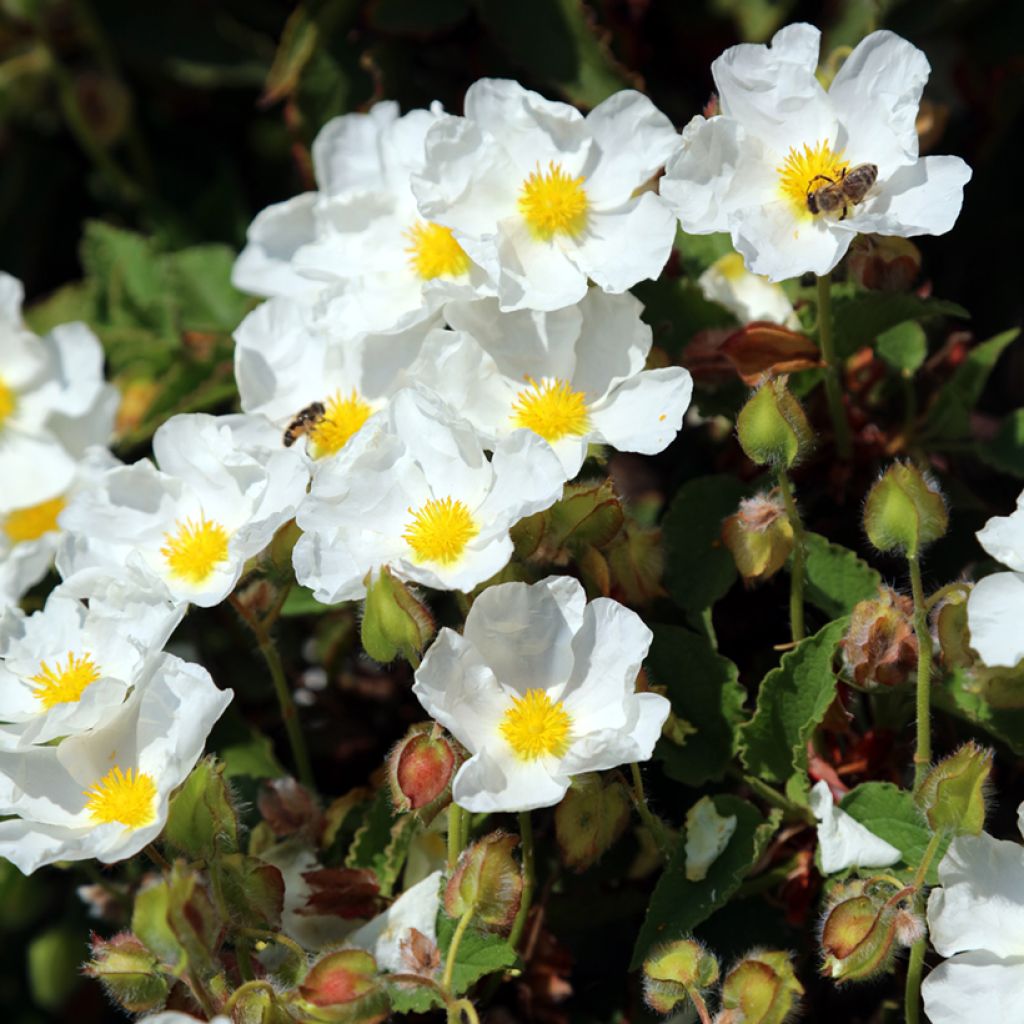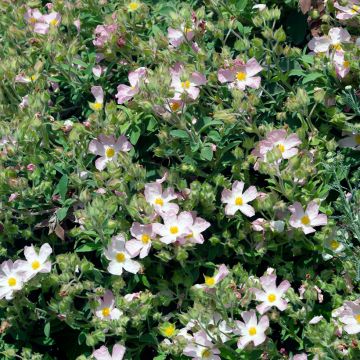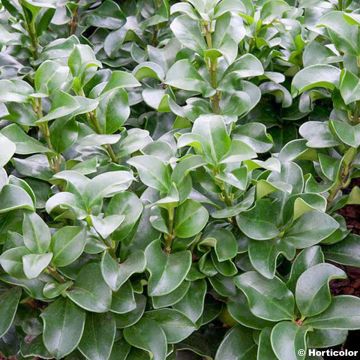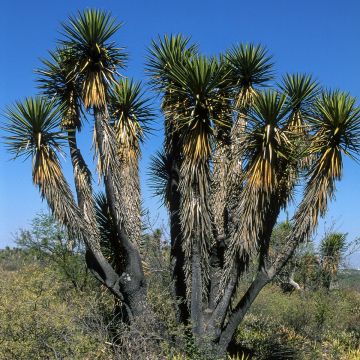Shipping country and language
Your country of residence may be:
Your country of residence is:
For a better user experience on our website, you can select:
Your shipping country:
-
Andorra
-
Austria
-
Belgium
-
Bulgaria
-
Canada
-
Chile
-
Croatia
-
Cyprus
-
Czechia
-
Denmark
-
Estonia
-
Finland
-
France
-
Germany
-
Greece
-
Hungary
-
Iceland
-
Ireland
-
Italy
-
Latvia
-
Lithuania
-
Luxembourg
-
Malta
-
Monaco
-
Netherlands
-
Poland
-
Portugal
-
Romania
-
Slovakia
-
Slovenia
-
Spain
-
Sweden
-
Switzerland
-
United Kingdom
We only deliver seed and bulb products to your country. If you add other products to your basket, they cannot be shipped.
Language:
-
French
-
German
-
Spanish
-
English
-
Italian
My Account
Hello
My wish lists
Log in / Register
Existing customer?
New customer?
Create an account to track your orders, access our customer service and, if you wish, make the most of our upcoming offers.


Cistus populifolius - Poplar-leaved Rockrose


Cistus populifolius - Poplar-leaved Rockrose


Cistus populifolius - Poplar-leaved Rockrose


Cistus populifolius - Poplar-leaved Rockrose


Cistus populifolius - Poplar-leaved Rockrose
Cistus populifolius - Poplar-leaved Rockrose
Cistus populifolius
Poplar-leaved Rockrose
Good recovery and immediate flowering
Danièle B., 03/10/2017
Why not try an alternative variety in stock?
View all →Order in the next for dispatch today!
Dispatch by letter from €3.90.
Delivery charge from €5.90 Oversize package delivery charge from €6.90.
More information
This item is not available in your country.
Schedule delivery date,
and select date in basket
This plant carries a 24 months recovery warranty
More information
We guarantee the quality of our plants for a full growing cycle, and will replace at our expense any plant that fails to recover under normal climatic and planting conditions.
From €5.90 for pickup delivery and €6.90 for home delivery
Express home delivery from €8.90.
Does this plant fit my garden?
Set up your Plantfit profile →
Description
Cistus populifolius, also known as Poplar-leaved Rockrose, is interesting for its coloured foliage in winter, its beautiful stature, and its hardiness, allowing it to withstand down to -12/-15°C (10.4/5°F) in well-drained soil. This botanical species forms a beautiful, branching and fragrant shrub with an upright habit. It bears large, green, evergreen leaves and offers a profusion of white flowers in spring with a golden stamen heart. Like many rockroses, it is highly resistant to drought, but it also stands out for its good tolerance to partially shaded exposures.
The poplar-leaved rockrose belongs to the cistaceae family. It is widespread in France, northern Spain and Portugal. It is a beautiful shrub that can easily reach a height of 2m (6.5ft), with a spread of 1m (3.3ft). Its growth is quite slow, the plant ages relatively well, and lives for 12 to 15 years. The flowering takes place in spring or early summer depending on the climate and lasts about a month. The flowers are composed of 5 white petals and gathered in corymbs. They are round and open, with a diameter of 4 to 6 cm (1.6 to 2.4 in), enhanced by numerous bright yellow stamens. They only live for a day, covering the ground with their petals in the late afternoon, but will be replaced the next morning. The evergreen foliage consists of large, ovate, heart-shaped leaves that resemble those of certain poplars. They are dark green from spring to summer, paler underneath. The branches are sticky and highly fragrant.
This attractive shrub that thrives in acidic and poor soils can be used in mass plantings, large rock gardens and light woodland areas, under Japanese maples for example, alongside Phlomis samia. Create a small informal hedge to accompany your rockrose, by associating it with tree heathers, brooms, bottlebrushes, or bushy ceanothuses. You can plant it in well-drained soil almost anywhere but for the coldest regions, it is better to cultivate it in large pots, ensuring good drainage and watering abundantly (with non-chalky water) but sparingly, allowing the substrate to dry out between waterings.
Report an error about the product description
Cistus populifolius - Poplar-leaved Rockrose in pictures






Plant habit
Flowering
Foliage
Botanical data
Cistus
populifolius
Cistaceae
Poplar-leaved Rockrose
Mediterranean
Other Cistus - Rockrose
Planting and care
Cistus populifolius requires a light, well-drained, sandy, acidic and poor soil. Plant it after the last frost in the north and in September-October in hot and dry climates. It thrives in both full sun and light shade, or even in more pronounced shade in warm regions, and tolerates competition from the roots of mature trees fairly well. In these conditions, it is hardy down to -12°C/-15°C (10.4/5 °F) and will live longer. Mulch it in winter in the coldest regions, and protect it from the cold as much as possible. Place it in a warm spot in the garden, in full sun or against a south-facing wall, in a rocky or sandy slope in any substrate that does not retain moisture, which would be fatal to it in winter or summer, which is its period of vegetative rest. The combination of heat and humidity leads to the development of a fungus that attacks the collar of the plant and would be as fatal to it as a Siberian cold. You can prune the stems after flowering to encourage the plant to branch out. Avoid severe pruning.
Planting period
Intended location
Care
-
, onOrder confirmed
Reply from on Promesse de fleurs
Evergreen shrubs
Haven't found what you were looking for?
Hardiness is the lowest winter temperature a plant can endure without suffering serious damage or even dying. However, hardiness is affected by location (a sheltered area, such as a patio), protection (winter cover) and soil type (hardiness is improved by well-drained soil).

Photo Sharing Terms & Conditions
In order to encourage gardeners to interact and share their experiences, Promesse de fleurs offers various media enabling content to be uploaded onto its Site - in particular via the ‘Photo sharing’ module.
The User agrees to refrain from:
- Posting any content that is illegal, prejudicial, insulting, racist, inciteful to hatred, revisionist, contrary to public decency, that infringes on privacy or on the privacy rights of third parties, in particular the publicity rights of persons and goods, intellectual property rights, or the right to privacy.
- Submitting content on behalf of a third party;
- Impersonate the identity of a third party and/or publish any personal information about a third party;
In general, the User undertakes to refrain from any unethical behaviour.
All Content (in particular text, comments, files, images, photos, videos, creative works, etc.), which may be subject to property or intellectual property rights, image or other private rights, shall remain the property of the User, subject to the limited rights granted by the terms of the licence granted by Promesse de fleurs as stated below. Users are at liberty to publish or not to publish such Content on the Site, notably via the ‘Photo Sharing’ facility, and accept that this Content shall be made public and freely accessible, notably on the Internet.
Users further acknowledge, undertake to have ,and guarantee that they hold all necessary rights and permissions to publish such material on the Site, in particular with regard to the legislation in force pertaining to any privacy, property, intellectual property, image, or contractual rights, or rights of any other nature. By publishing such Content on the Site, Users acknowledge accepting full liability as publishers of the Content within the meaning of the law, and grant Promesse de fleurs, free of charge, an inclusive, worldwide licence for the said Content for the entire duration of its publication, including all reproduction, representation, up/downloading, displaying, performing, transmission, and storage rights.
Users also grant permission for their name to be linked to the Content and accept that this link may not always be made available.
By engaging in posting material, Users consent to their Content becoming automatically accessible on the Internet, in particular on other sites and/or blogs and/or web pages of the Promesse de fleurs site, including in particular social pages and the Promesse de fleurs catalogue.
Users may secure the removal of entrusted content free of charge by issuing a simple request via our contact form.
The flowering period indicated on our website applies to countries and regions located in USDA zone 8 (France, the United Kingdom, Ireland, the Netherlands, etc.)
It will vary according to where you live:
- In zones 9 to 10 (Italy, Spain, Greece, etc.), flowering will occur about 2 to 4 weeks earlier.
- In zones 6 to 7 (Germany, Poland, Slovenia, and lower mountainous regions), flowering will be delayed by 2 to 3 weeks.
- In zone 5 (Central Europe, Scandinavia), blooming will be delayed by 3 to 5 weeks.
In temperate climates, pruning of spring-flowering shrubs (forsythia, spireas, etc.) should be done just after flowering.
Pruning of summer-flowering shrubs (Indian Lilac, Perovskia, etc.) can be done in winter or spring.
In cold regions as well as with frost-sensitive plants, avoid pruning too early when severe frosts may still occur.
The planting period indicated on our website applies to countries and regions located in USDA zone 8 (France, United Kingdom, Ireland, Netherlands).
It will vary according to where you live:
- In Mediterranean zones (Marseille, Madrid, Milan, etc.), autumn and winter are the best planting periods.
- In continental zones (Strasbourg, Munich, Vienna, etc.), delay planting by 2 to 3 weeks in spring and bring it forward by 2 to 4 weeks in autumn.
- In mountainous regions (the Alps, Pyrenees, Carpathians, etc.), it is best to plant in late spring (May-June) or late summer (August-September).
The harvesting period indicated on our website applies to countries and regions in USDA zone 8 (France, England, Ireland, the Netherlands).
In colder areas (Scandinavia, Poland, Austria...) fruit and vegetable harvests are likely to be delayed by 3-4 weeks.
In warmer areas (Italy, Spain, Greece, etc.), harvesting will probably take place earlier, depending on weather conditions.
The sowing periods indicated on our website apply to countries and regions within USDA Zone 8 (France, UK, Ireland, Netherlands).
In colder areas (Scandinavia, Poland, Austria...), delay any outdoor sowing by 3-4 weeks, or sow under glass.
In warmer climes (Italy, Spain, Greece, etc.), bring outdoor sowing forward by a few weeks.























